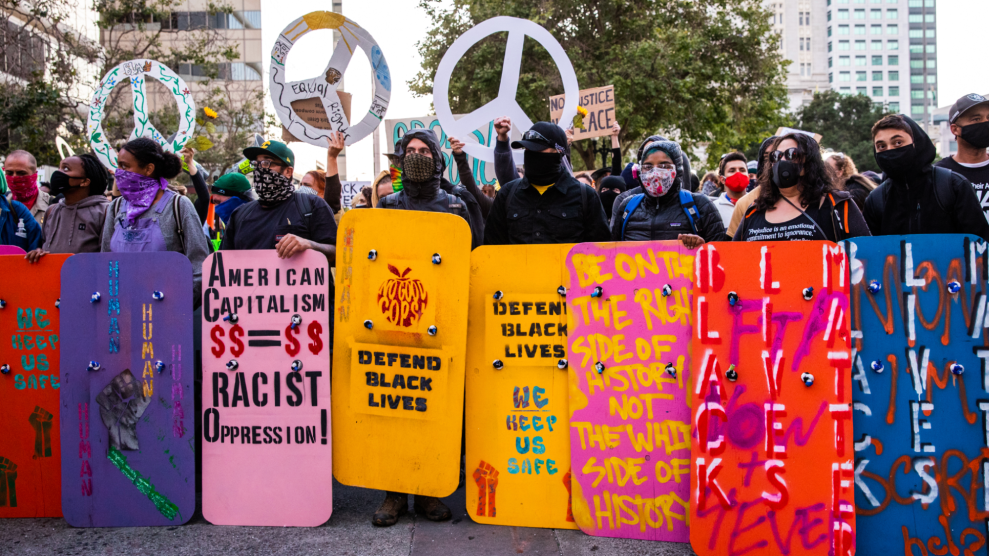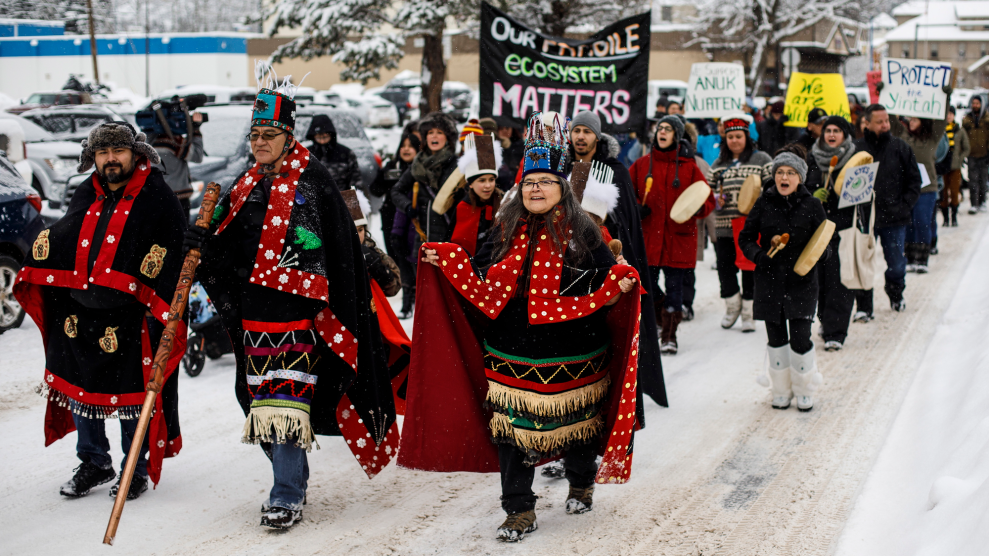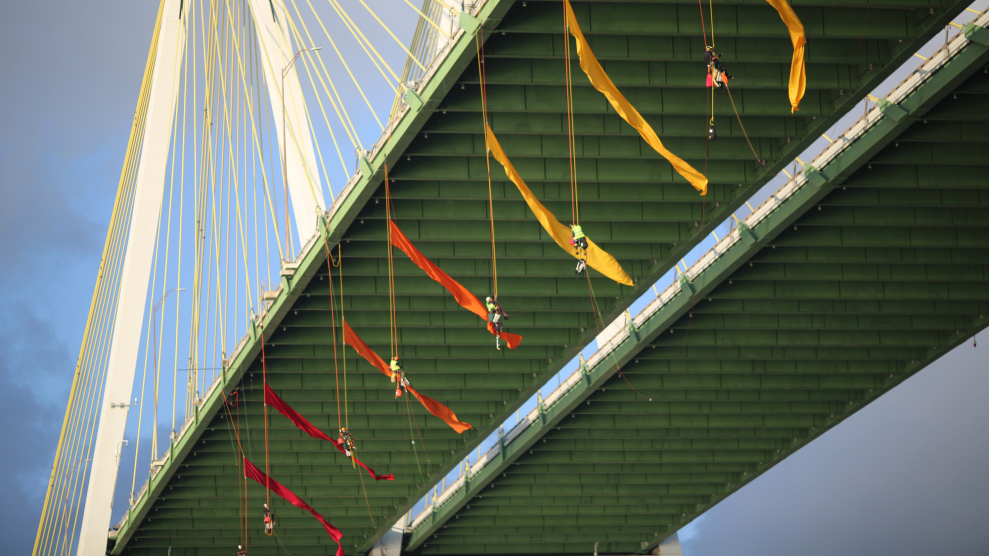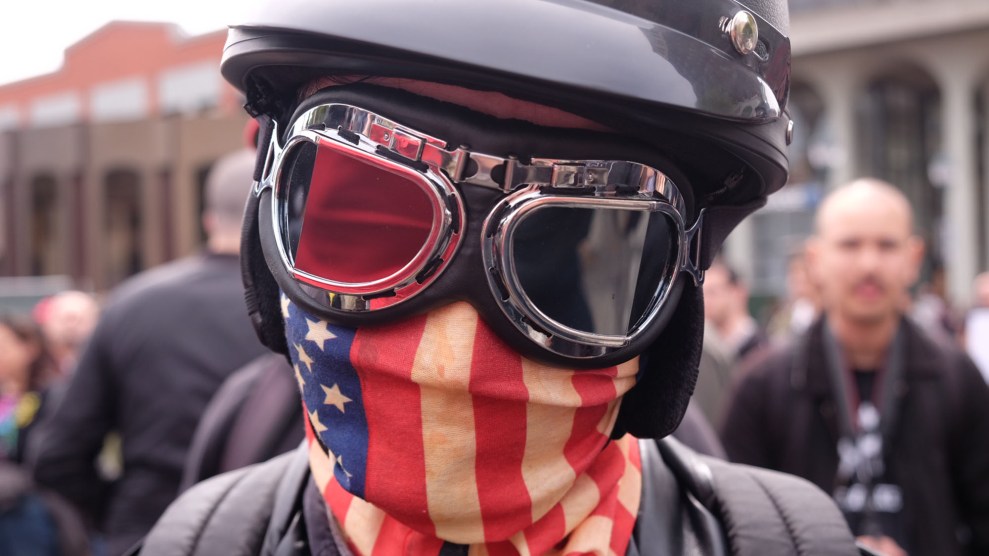
Protesters at a July demonstration in Oakland carry shields painted by the Oakland Builders Collective.Natasha Moustache/Getty
On this warm October afternoon, 30 people have gathered for a shield building party in West Oakland’s Lil Bobby Hutton Park. They kneel on a tarp splotched with spray-paint and glitter, stenciling slogans onto 2–by–4-foot plywood rectangles with rounded corners that have been buzz-sawed in batches of three. The shields are hefty, but are easily carried with one arm through the straps that are being attached to each one after it’s painted, along with a strip of foam to protect the forearm of someone carrying it for hours.
The shields are a project of the Oakland Builders Collective, a volunteer crew that has spent the past few months making 500 shields for protesters to use to protect themselves. So far, the collective has provided custom-made shields to more than 10 activist groups in 5 Bay Area cities. Even with the help of dozens of volunteers like those who have come out today, it is “already beyond capacity,” says F., one of the group’s founders, who requested that his name not be used out of concerns around doxxing.
Among the shield builders is a 29-year-old nonbinary farmer and medic I’ll call Sasha, who first used a shield at a racial justice protest this summer. One night in August, Sasha had arrived in downtown Oakland with a toolbelt loaded with granola bars, herbs to clean wounds, and a spray bottle filled with Maalox and water (a tear gas remedy). A hundred or so people had intended to march peacefully, but when someone smashed windows at a Whole Foods, police in riot gear moved in and declared the gathering an “unlawful assembly.”
Fear and confusion splintered the crowd, and someone handed Sasha a plywood shield. “I don’t even know what I’m gonna do with this,” they recall thinking. “There’s so many more cops than shields.” But as Sasha watched people run from the police, they could see how the marchers might have held their ground if they’d had more shields and better training—which is why they’re here making shields today.
As millions of Americans came out to protest peacefully after George Floyd’s killing in May, police in many cities responded with batons, pepper spray, tear gas, and projectiles. (As writer Craig Jenkins observed, “They couldn’t even stop doing police brutality at the police brutality protest.”) There’s no comprehensive data on the number of people officers injured, yet nearly 1,000 instances of police brutality have been documented; a class action lawsuit alleges that federal agents wounded hundreds in Portland alone.
The violent response left some activists wondering what might happen if mass demonstrations became necessary to protest or protect the election results. Organizers in the Bay Area have spent recent months making and distributing shields, helmets, gas masks, and other tools to protect protesters. “We don’t want people getting hurt anymore,” says Eddie, another shield builder who wanted to withhold their real name. Cops often point to broken windows and objects being thrown claim that protesters get violent first, but in Eddie’s experience, it’s “always” the police who escalate. “Rather than us just being there as targets, we’re trying to be proactive,” by building shields, he says. He thinks American activists are “fortunate” to have not faced the kinds of violence and repression seen in places like Venezuela and Ukraine. But just because the police haven’t gone to such extremes, says Eddie, it “doesn’t mean that they’re not willing to.”
Homemade defenses for protesters are as old as efforts to shut down protests. French dissidents have long built fearsome barricades, a practice Victor Hugo immortalized in Les Misérables as “an insane but heroic defiance.” A shield-making manual published in 2012 and used by activists today credits its approach to the “White Overalls” movement of the 1990s, which buoyed anti-globalization protests by flooding Europe’s streets with dense crowds protected by rubber inner tubes. More recently, Portland’s “Wall of Moms” inspired copycats overseas when it protected demonstrators by linking up with pool noodles. The Oakland shield builders have also sought inspiration from videos of Hong Kongers using umbrellas and leaf-blowers to avoid tear gas and Chileans shielding themselves with stop signs and kitchen sinks.
Yet protesters aren’t the only ones practicing such “tactical innovation,” explains Ashley Howard, a history professor at the University of Iowa who studies race and public protest. Today’s protesters are staring down heavily equipped cops who are sometimes armed with water cannons, sonic weapons, and powerful stink bombs. (The National Guard considered using heat rays on protesters in Washington, DC this summer.) “Non-lethal” projectiles like bean bag rounds and rubber bullets can fracture skulls, damage eyes, and sometimes kill. And then there are the planes that can mop up cellphone data and artificial intelligence platforms that use social media to track activists. “The new methods of controlling protest are very powerful,” Howard says.
It’s not just police violence activists are worried about. Protests have also attracted armed counterprotesters like Kyle Rittenhouse, the 17-year-old who allegedly shot and killed two people and injured a third in Kenosha, Wisconsin. The deadly car attack on antiracist protesters in Charlottesville, Virginia, which killed Heather Heyer and injured 28 others in 2017, nearly replayed itself dozens of times this summer. “For so long Americans have taken for granted that if we go out to protest, we’ll come home that night,” Howard says. “Many instances over the past few years have called that into question.” Yet, she notes, “People are still willing to put themselves on the line to protect their ability to fully engage in this country.”
While the shield makers I interviewed had serious concerns about the election, none suggested it was the only reason they were thinking about self-defense. They expect to be out in the streets again soon regardless of who wins the presidency. Many community groups—including some “that you wouldn’t think would support frontline rowdy protests,” says F.—have requested shields, anticipating a need for protection whether they’re mobilizing against an attempt to steal the election for President Donald Trump or continued police brutality during a Biden administration.
F. sees shields as a kind of insurance, a way to make people feel safer so they can stand up to defend democracy. “It’s easier to think through elections,” he says, “if you’re not afraid for your life.” He witnessed the utility of shields in Berkeley in 2017, when right-wing extremists hurled batteries and unopened soda cans at antifascist demonstrators. F. noticed people protecting themselves with black-painted shields that were “very anarchist-y.” (The Oakland Builders Collective’s shields are painted in bright colors with recognizable slogans that are meant to make them and their bearers less intimidating and more trustworthy to diverse crowds.) Along with a group called Gear Up Oakland, the collective has raised money to distribute shields as well as gas masks and bulletproof vests to activists.
Rachel Lederman, an attorney with the National Lawyers Guild, which provides legal support to protesters, says it is legal to bring shields to demonstrations in California. However, she says, if a shield were used aggressively against a police officer or to obstruct an arrest, prosecutors might label it a weapon, leading to a more serious charge. Sasha says they’ve seen cops confiscate shields and target shield-carriers for arrest. F. was recently charged with assault with a deadly weapon on a police officer for allegedly throwing a smoke grenade during a rally; he believes this was a pretense to search his apartment for shield-making materials and instructions.
A shield isn’t worth much if you don’t know how to use it, so the Builders Collective leads weekly trainings next to Lake Merritt in downtown Oakland. On a recent Sunday, an ethnically, generationally, and gender diverse group of 21 trainees showed up to learn how to protect themselves by forming walls of overlapping shields.
An advanced group, most wearing helmets, practiced using their shields in a testudo or “turtle” formation, a technique used by ancient Roman armies and still employed by police. The technique, which creates a covered wall around the shield bearers, could help protect protesters—and their eyes—from projectiles. At least 20 people were blinded or suffered serious eye damage from rubber bullets during this year’s protests. Once the shields were “turtled,” the trainers invited participants to chuck objects at the formation. A hailstorm of helmets, shoes, and metal water bottles rained down, but no one behind the plywood was hurt. The shield wall also withstood the trainers ramming it with batons and hurling themselves against it.
One of those inside the turtle was Sasha, who has attended several trainings and now feels more confident with a shield. But they still think being in the streets will be different. “When you’re scared, and when you have adrenaline, it’s like your brain starts to work in a different way,” they say. “It’s good to go out with a group of people that have practiced together and trained together, that have each other’s backs.”
Sasha sees shield-making as part of a larger project to “demystify the police” and empower protesters. “People are ready to engage in community self-defense in a way that I haven’t seen people be ready to do for a long time,” they say at the shield build in the park. “People who would normally think, ‘The cops are here to protect us’ are realizing that that’s not true.” Nearby, a teacher is stenciling a shield spray-painted lavender and periwinkle with the slogan “WE KEEP US SAFE.”
This article has been updated to change the name of a confidential source.















